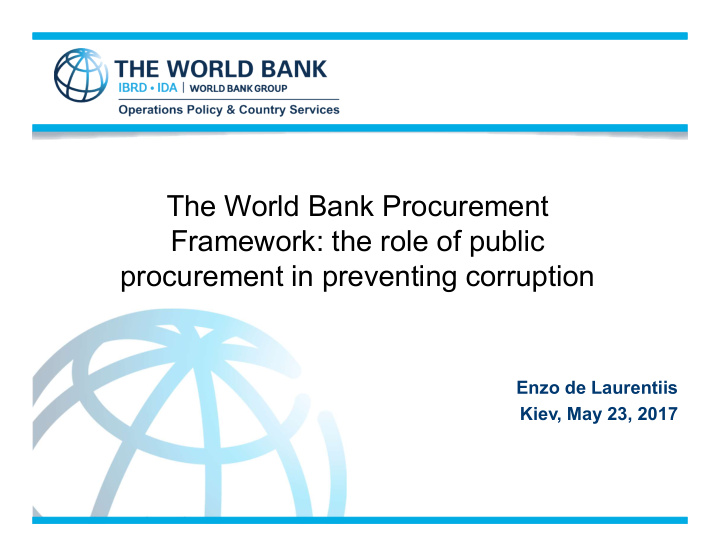



The World Bank Procurement Framework: the role of public procurement in preventing corruption Enzo de Laurentiis Kiev, May 23, 2017
Sound Procurement is at the Heart of Good Governance Governments and citizens engaging to design and implement policies that improve lives Effective institutions and the machinery of government The rule of law and the role of law A central, but evolving role in confronting corruption 1
Why is a Sound Procurement System Central to Preventing Corruption? Government activity most vulnerable to F&C - approximately a third of government spending, and 12% of GDP in OECD countries Corruption distorts allocative efficiency, and inflicts major, long lasting costs on societies Preventing corruptions helps generate significant fiscal savings and engenders trust in institutions 2
The Logic of Modern Procurement Rules Regulate interactions between government and domestic/international markets Instrument of public policy Resolve tension between efficiency and integrity Drive behavior toward functional performance Seek innovative solutions to deliver better services with value for money Balance key stakeholders’ interests Make strategic use of technology 3
The World Bank’s Global Impact Bank funds over 1,800 investment projects in 136 countries Generates up $20 Billion a year procurement market Approximately 6,000 contracts awarded annually Support to modernization in most countries of operation Benchmarking Public Procurement (180 countries so far) Global partnerships and knowledge sharing 4
Core Procurement Principles 5
Key Features More upfront analysis and design More options for tailored procurement approaches, and hands-on expanded implementation support Promotes strategic engagements with providers Enables the use of sustainable procurement criteria Improves the approach to resolving procurement-related complaints (e.g. stand-still period) More involvement in contract management to ensure the best possible outcomes and that problems are resolved quickly Risk-based and proportional Enhances integrity, transparency, and accountability 6
Greater Focus On Procurement Planning Project Procurement Strategy for Development (PPSD) new market analysis and procurement planning tool risk-based approach addresses how the procurement will support development and deliver best VfM forms the basis of the procurement plan proportional to the risk, value and complexity of the procurement living document – can be updated periodically electronic procurement planning and monitoring system (STEP) 7
Promoting Integrity Bank’s Anti-Corruption Guidelines and sanctions procedure Up-front dialogue on integrity matters to determine appropriate integrity controls in support of the selected procurement method and approaches (competitive dialogue, negotiations) Greater interaction on integrity matters with specialists in relation to actual contract delivery and results measurement Use of technologies—e-procurement, open data, and geo- tagging of procurement activities 8
Promoting Integrity - continued 9
Anti-corruption Provisions Bank’s Anti-corruption provisions are contained in full in each SPD: defining the sanctionable practices of corruption, fraud, collusion and coercion sanctioning those engaged in sanctionable practices declaring ineligibility of those sanctioned in according with WB prevailing sanctions policies requiring Bank’s right to inspect Where SPDs are not used, (e.g. alternative procurement arrangements, national competitive procurement) consultants will be required to accept the application of, and agreed to comply with, the Bank’s Anti-corruption provisions 10
Unlocking the Power of Information Adequate and timely disclosure Data analytics – measuring performance Focus on outcomes rather than procedure, including for corruption indicators Comprehensive data consumption strategies Citizens’ participation and closing the feed-back loop 11
Leveraging Collaboration and Global Fora MDB harmonization – cross-debarment Open Contracting OECD - MAPS PEFA, GIFT, COST Global standards (INTOSAI,IFAC, etc.) G-20 (illicit financial flows, tax transparency, Beneficial Ownership, etc.) 12
Open Contracting • Improving the disclosure of contract information and data by providing guidance on the type of data to be published and by proposing application of open and standardized disclosure formats • Creating opportunities for stakeholder participation for effective use of information and data in the monitoring and oversight of contract management • Advancing mechanisms for constructive multi-stakeholder engagement around contract performance • 19 countries adopted OC commitments during UK Anti- corruption summit and 5 of these have programs with the WB 13
World Bank Procurement App (link)
Beneficial Ownership • Natural person who ultimately owns or controls a company (25% or more) • FATF recommendations and evolving international practice • Aligned with initiatives on AML, company registration, anti- terrorism, and Stolen Assets Recovery • WB Standard Procurement Documents require winning bidder to provide B/O information • Information published with contract award • Misrepresentation of B/O information may be investigated and sanctioned 15
MAPS – Pillar IV Harmonized approach to assess the domestic system Revised MAPS includes more quantitative indicators Describes an ideal operating environment Enhanced focus on civil society and access to information Reliable and efficient control and audit The importance of procurement appeal mechanisms Ethics and anti-corruption measures 16
Recommend
More recommend